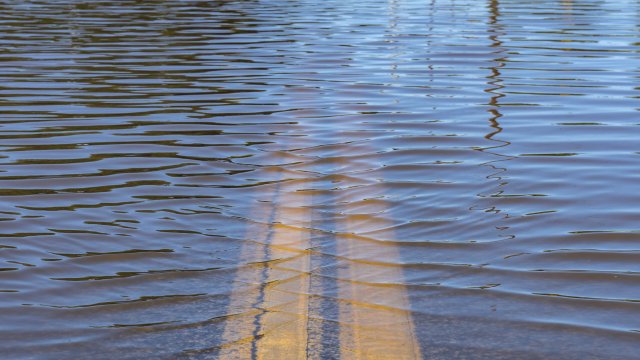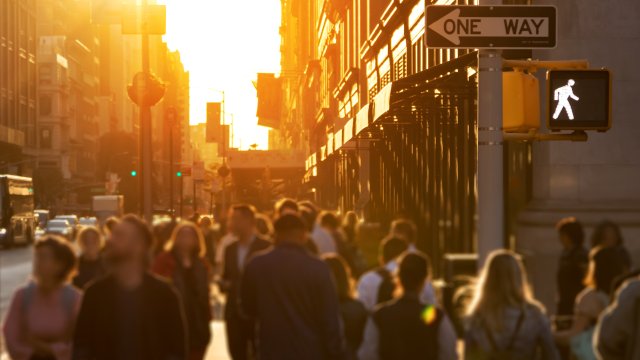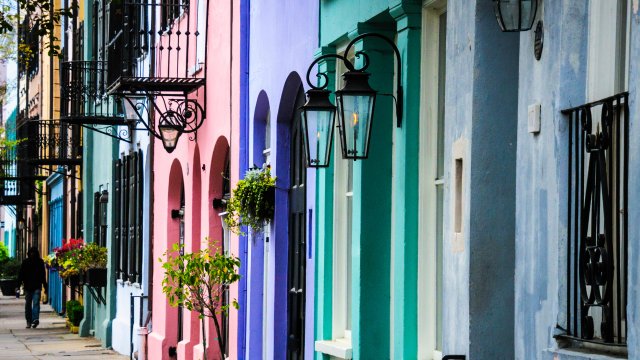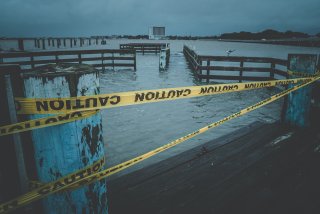Climate Change Impacts on the Built Environment
Overview
The built environment includes structures and systems that provide places for people to live, work, and play. It includes buildings, roads, bridges, parks, streets, and systems that provide transportation, water, power, and more. These structures and systems exist in nearly all places where people live and work, but tend to be most concentrated in metropolitan areas. About 85% of Americans live in metropolitan areas, and that number is projected to grow over the next 100 years.1
-

More urban flooding. Intense, single-day rainstorms are rising, increasing the risk of urban flooding, especially in areas with a lot of paved surfaces.35
-

Increased heat impacts. Many cities already experience urban heat islands. Now, unusually hot summer days and nights are also becoming more common.36 Urban residents can face more heat illnesses, power outages, and higher energy prices as a result.
-

Increased property damage. Charleston, South Carolina, is at risk for coastal flooding and sea level rise, both of which can cause damage to historic buildings and landmarks. The city is elevating some buildings to protect them from climate change.
-

Reduced air quality. In the West, wildfires are on the rise, affecting air quality in nearby cities while also posing risks to people and property.

Climate change affects cities differently depending on their location. Many cities are already dealing with multiple impacts from climate change. For example, some experience more frequent and longer heat waves.2 Those impacts worsen the temperature problems caused by urban heat islands—that is, city areas with higher temperatures than outlying areas.3 At the same time, some urban areas are experiencing repeated flooding from heavy rains that overwhelm drainage systems. Others face flooding problems due to losses of wetlands and forests that once absorbed rainfall.4
In addition, the built environment interacts with and depends on other sectors of the economy, such as water, transportation, and energy . So, climate impacts on these sectors can also affect the built environment.
Cities are taking steps to adapt to climate change. These actions are helping to protect the built environment, improve land-use planning, and increase emergency preparedness. For example, many cities are planting trees, installing green roofs, and adding green spaces. These measures help improve air quality and cool urban areas. More permeable ground cover also absorbs rainfall, reducing runoff and flooding. Some governments are using policy measures, like building codes and zoning laws, to protect the built environment and city residents from climate change.5
Explore the sections on this page to learn more about climate impacts on the built environment:
- Top Climate Impacts on the Built Environment
- The Built Environment and the Economy
- Environmental Justice and Equity
- What We Can Do
- Related Resources
Top Climate Impacts on the Built Environment
Climate change has multiple effects on the built environment. Three key impacts are described in this section.
1. Damaged or Stressed Infrastructure

A lot of U.S. infrastructure is nearing the end of its life. This aging infrastructure is threatened by extreme weather events—some of which are already becoming more frequent and/or more intense.7
Climate change impacts on infrastructure vary by region. For example, in coastal regions, high tide flooding has harmed or destroyed infrastructure and private property.8 In the West, wildfires are already damaging property and affecting air quality.9 In floodplains across the nation, extreme precipitation can cause dam failures, bridge washouts, and road closures.10 Many cities also have outdated or aging sewer systems that intense rainfall can overwhelm, causing untreated wastewater to flow into local water bodies.11
Extreme temperatures can also stress the U.S. energy system.13 Failing cooling systems can lead to high indoor temperatures that endanger workers' health and reduce productivity.14 Transportation systems are also vulnerable to multiple climate change stressors, including extreme temperatures and heavy precipitation.15 Flooding from extreme precipitation and other climate impacts can cause billions of dollars of damage to transportation infrastructure annually.16 Meanwhile, high temperatures can stress bridge integrity and weaken rail systems.17
2. Impacts on the Production and Distribution of Goods and Services

Urban centers produce many goods that are important to the economy at local to global scales. Cities also provide many essential services to the public, such as telecommunications, energy, water, health care, and transportation.
A network of interconnected systems supports the flow of these goods and services. Climate change poses multiple and far-reaching risks to these systems.18 For example, extreme weather can cause power outages that disrupt transportation, interrupt supply chains, limit communication, and make it difficult for people to access health care.
3. Threats to Quality of Life and Human Health
Cities provide access to jobs, education, recreation, arts, culture, and much more. But many cities already face challenges with aging infrastructure, social inequities, and other problems. Climate change can worsen these problems and pose additional risks. For example, climate impacts on air quality and water quality can affect people’s health. Flooding can force people to evacuate their homes, affecting their mental and physical health. Sea level rise, flooding, and wildfires also threaten some historic landmarks, playgrounds, and cultural sites.
Forests, open spaces, and waterways in urban areas provide a wide range of benefits, but many are stressed due to development, pollution, and invasive species.19 These existing challenges can reduce their resilience to climate change effects.20
For more specific examples of climate change impacts in your region, please see the National Climate Assessment.
The Built Environment and the Economy
Urban areas are important engines of economic growth—hubs for producing and consuming goods and services. In 2015, urban areas contributed about 91% of the United States’ gross domestic product (GDP). The five largest cities in the country accounted for 23% of the GDP.21 In addition, urban lands are worth trillions of dollars.22
However, cities also bear the burden of aging and declining infrastructure that needs major financial investments to replace or repair. Not addressing this problem could cost the U.S. GDP up to $3.9 trillion by 2025.23 This estimate considers reduced goods production, lost trade, disrupted supply chains, fewer jobs, and lower wages. Services like transportation, water, electricity, and sanitation would also be affected, impacting people’s health and quality of life.
Environmental Justice and Equity

Some groups of urban residents are especially vulnerable to climate change impacts on the built environment. For example, children, older adults, outdoor workers, and people with some medical conditions are all sensitive to extreme heat.24 The urban heat island effect in built-up areas will intensify the effects of extreme heat events and reduce the relief provided by cooler temperatures at night.25 People who lack housing or who live in homes without adequate insulation or cooling are also more at risk for heat stress.26
In addition, many groups of urban residents live with high levels of air pollution.27,28 Black and African American individuals are 34% more likely to live in areas with the highest projected increases in childhood asthma due to climate-related changes in particulate matter.29
People who live in buildings that are older or in poor condition can be more exposed to outdoor pollutants and allergens.30 These buildings may also sustain more damage during extreme weather, such as storms and floods. This can lead to damp indoor environments prone to mold and bacteria.31
Climate change can also affect food security in urban areas.32 For example, power outages from extreme weather can cause food spoilage. Climate impacts on agriculture and transportation may affect supply chains, food prices, and availability.33 People who already have limited access to food will be affected the most. These include households with an income below the poverty threshold, those headed by a single woman, and those with Black or Hispanic owners or lessees.34
What We Can Do
We can reduce the impact of climate change on the built environment in many ways, including the following:
- Go for the green. Green roofs, greenways, trees, and other green infrastructure all help reduce the urban heat island effect and absorb rainwater to prevent flooding. They also provide benefits like improved air quality and habitat for wildlife.
- Create climate action plans. City governments can develop plans to identify vulnerabilities in the built environment and reduce the impacts of climate change.
- Build climate smart. Planners should build with resilience in mind by considering projected climate changes and smart growth strategies, as well as planning for natural disasters in advance.
- Address inequities. Cities can take action to reduce climate impacts on all citizens and promote environmental justice. For example, consider vulnerable populations when planning cooling centers, transportation routes, and green spaces.
- Get coordinated. Climate responses often require coordination among many agencies and sectors. EPA’s regional climate adaptation coordinators can help provide guidance and resources.
See additional actions you can take, as well as steps that companies can take, on EPA’s What You Can Do About Climate Change page.
Related Resources
- Fifth National Climate Assessment, Chapter 12: “Built Environment, Urban Systems, and Cities.”
- Green Infrastructure for Climate Resiliency. Provides resources on green infrastructure planning, education, publications, and funding opportunities.
- Smart Growth. Provides an array of resources on climate-smart development in cities.
- Heat Island Effect. Offers resources and strategies for understanding and reducing the urban heat island effect. Includes information on heat islands and equity.
- Sustainable Management of Construction and Demolition Materials. Provides ways to help divert materials from disposal by practicing source reduction, salvaging, recycling, and material reuse, as well as strategies for buying used and recycled products.
- Disaster Debris Recovery Tool. Provides guidance and an interactive tool for cities with aging and damaged infrastructure facing natural disasters.
- Sustainable Materials Management Prioritization Tools. Includes life cycle-based tools to help users identify opportunities for environmental improvement in the production and consumption of goods and services.
- Built Environment Toolkit. Developed by multiple organizations to provide information and solutions to help address the multiple climate stressors on the built environment.
- Centers for Disease Control and Prevention: Built Environment Assessment Tool. Helps organizations measure features of the built environment that affect people’s health.
Endnotes
1 Maxwell, K., et al. (2018). Ch. 11: Built environment, urban systems, and cities. In: Impacts, risks, and adaptation in the United States: Fourth national climate assessment, volume II. U.S. Global Change Research Program, Washington, DC, p. 442.
2 Marvel, K. et al. (2023). Ch. 2: Climate Trends. Fifth National Climate Assessment. U.S. Global Change Research Program, Washington, DC, p. 2-17.
3 Chu, E. K., et al. (2023). Ch. 12: Built environment, urban systems, and cities. Fifth National Climate Assessment. U.S. Global Change Research Program, Washington, DC, p. 12-10.
4 Clarke, L., et al. (2018). Ch.17: Sector interactions, multiple stressors, and complex systems. In: Impacts, risks, and adaptation in the United States: Fourth national climate assessment, volume II. U.S. Global Change Research Program, Washington, DC, p. 644.
5 Chu, E. K., et al. (2023). Ch. 12: Built environment, urban systems, and cities. Fifth National Climate Assessment. U.S. Global Change Research Program, Washington, DC, p. 12-17.
6 Maxwell, K., et al. (2018). Ch. 11: Built environment, urban systems, and cities. In: Impacts, risks, and adaptation in the United States: Fourth national climate assessment, volume II. U.S. Global Change Research Program, Washington, DC, p. 442.
7 Marvel, K. et al. (2023). Ch. 2: Climate Trends. Fifth National Climate Assessment. U.S. Global Change Research Program, Washington, DC, p. 2-16.
8 May, C. et al. (2023). Ch. 9: Coastal Effects. Fifth National Climate Assessment. U.S. Global Change Research Program, Washington, DC, p 9 –4.
9 Chu, E. K., et al. (2023). Ch. 12: Built environment, urban systems, and cities. Fifth National Climate Assessment. U.S. Global Change Research Program, Washington, DC, p. 12-13.
10 Liban, C., et al. (2023). Ch. 13: Transportation. Fifth National Climate Assessment. U.S. Global Change Research Program, Washington, DC, p. 13-8.
11 Maxwell, K., et al. (2018). Ch. 11: Built environment, urban systems, and cities. In: Impacts, risks, and adaptation in the United States: Fourth national climate assessment, volume II. U.S. Global Change Research Program, Washington, DC, p. 451.
12 Chu, E. K., et al. (2023). Ch. 12: Built environment, urban systems, and cities. Fifth National Climate Assessment. U.S. Global Change Research Program, Washington, DC, p. 12-12.
13 Zamada, C.D., et al. (2023). Ch. 5: Energy, Supply, Delivery, and Demand Fifth National Climate Assessment. U.S. Global Change Research Program, Washington, DC, p. 5 -7.
14 Maxwell, K., et al. (2018). Ch. 11: Built environment, urban systems, and cities. In: Impacts, risks, and adaptation in the United States: Fourth national climate assessment, volume II. U.S. Global Change Research Program, Washington, DC, p. 449.
15 Liban, C., et al. (2023). Ch. 13: Transportation. Fifth National Climate Assessment. U.S. Global Change Research Program, Washington, DC, p. 13-8.
16 Chu, E. K., et al. (2023). Ch. 12: Built environment, urban systems, and cities. Fifth National Climate Assessment. U.S. Global Change Research Program, Washington, DC, p. 12-15.
17 Liban, C. et al. (2023). Ch. 13: Transportation. Fifth National Climate Assessment. U.S. Global Change Research Program, Washington, DC, p. 13-8.
18 Chu, E. K., et al. (2023). Ch. 12: Built environment, urban systems, and cities. Fifth National Climate Assessment. U.S. Global Change Research Program, Washington, DC, p. 12-5.
19 Maxwell, K., et al. (2018). Ch. 11: Built environment, urban systems, and cities. In: Impacts, risks, and adaptation in the United States: Fourth national climate assessment, volume II. U.S. Global Change Research Program, Washington, DC, p. 442.
20 Maxwell, K., et al. (2018). Ch. 11: Built environment, urban systems, and cities. In: Impacts, risks, and adaptation in the United States: Fourth national climate assessment, volume II. U.S. Global Change Research Program, Washington, DC, p. 442.
21 Maxwell, K., et al. (2018). Ch. 11: Built environment, urban systems, and cities. In: Impacts, risks, and adaptation in the United States: Fourth national climate assessment, volume II. U.S. Global Change Research Program, Washington, DC, p. 442.
22 Maxwell, K., et al. (2018). Ch. 11: Built environment, urban systems, and cities. In: Impacts, risks, and adaptation in the United States: Fourth national climate assessment, volume II. U.S. Global Change Research Program, Washington, DC, p. 440.
23 Maxwell, K., et al. (2018). Ch. 11: Built environment, urban systems, and cities. In: Impacts, risks, and adaptation in the United States: Fourth national climate assessment, volume II. U.S. Global Change Research Program, Washington, DC, p. 442.
24 Hayden, M. H., et al. (2023). Ch. 15: Human Health. Fifth National Climate Assessment. U.S. Global Change Research Program, Washington, DC, p. 15-6.
25 Hayden, M. H., et al. (2023). Ch. 15: Human Health. Fifth National Climate Assessment. U.S. Global Change Research Program, Washington, DC, p. 15-18.
26 Hayden, M. H., et al. (2023). Ch. 15: Human Health. Fifth National Climate Assessment. U.S. Global Change Research Program, Washington, DC, p. 15-18.
27 West, J.J., et al. (2023). Ch. 14: Air quality. Fifth National Climate Assessment. U.S. Global Change Research Program, Washington, DC, 14-11.
28 Gamble, J.L., et al. (2016). Ch. 9: Populations of concern. In: The impacts of climate change on human health in the United States: A scientific assessment. U.S. Global Change Research Program, Washington, DC, p. 253.
29 EPA. (2021). Climate change and social vulnerability in the United States: A focus on six impacts. EPA 430-R-21-003, pp. 24–25.
30 Fann, N., et al. (2016). Ch. 3: Air quality impacts. In: The impacts of climate change on human health in the United States: A scientific assessment. U.S. Global Change Research Program, Washington, DC, pp. 82–83.
31 EPA. (2021). Indoor air quality and climate change. Retrieved 3/18/2022.
32 Maxwell, K., et al. (2018). Ch. 11: Built environment, urban systems, and cities. In: Impacts, risks, and adaptation in the United States: Fourth national climate assessment, volume II. U.S. Global Change Research Program, Washington, DC, p. 452.
33 Maxwell, K., et al. (2018). Ch. 11: Built environment, urban systems, and cities. In: Impacts, risks, and adaptation in the United States: Fourth national climate assessment, volume II. U.S. Global Change Research Program, Washington, DC, p. 447.
34 Coleman-Jensen, A., et al. (2020). Household food security in the United States in 2020 (pdf). ERR-298, U.S. Department of Agriculture, Economic Research Service, p. v.
35 EPA. (2021). Climate change indicators: Heavy precipitation. Retrieved 3/18/2022.
36 EPA. (2021). Climate change indicators: High and low temperatures. Retrieved 3/18/2022.
